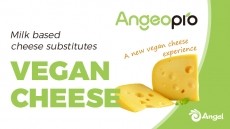‘It is important that we stay ahead of the trends’: Kerry CEO shares insight into food industry fashions

Kerry Group reported an increase in first-half sales yesterday (9 August), with higher volumes at its taste and nutrition business propelling the result.
Kerry’s first-half by the numbers
Kerry booked an 8% rise in sales during the first six months of the year on a constant currency basis, with revenue rising to €3.23bn, However, factoring in FOREX sales grew just 1.4%.
Currency exchange also weighed on trading profit growth, which was up 8.7% excluding currencies and 0.5% on a reported basis to €340m.
Computer software amortisation charges weighed on pre-tax profit, which stood at €291.3m compared to €292.1m in the comparable period of last year. However, post tax profit edged up to €226.7m versus €225.1m.
Updating its full-year guidance, Kerry said it now expects to achieve growth in adjusted earnings per share of 7% to 10% in constant currency.
Chief executive Edmond Scanlon attributed what he described as the “underlying strength” of Kerry’s performance to the Irish company’s ability to identify consumer trends and translate them into actionable innovation for its customers.
“Evolving consumer trends and the changing marketplace have provided increased opportunities and demand for Kerry’s industry leading RD&A and broad technology portfolio,” Scanlon commented. “It is important that we stay ahead of the trends.”
In order to achieve this, Kerry leverages its proprietary suit of in-house digital tools to create “intimacy” with consumers around the world. This insights framework consists of various applications, including Kerry Compass, Eat the Streets, Kerry Trend Spotting and Consumer Radar.
“We understand the trends and can distil those into key insights and working with our customers into products,” Scanlon explained.
Localisation and fragmentation
The first “key theme” identified by Scanlon is a growing shift towards what he termed “localisation”.
“Localisation continues to drive innovation and capture market share,” he noted.
Scanlon cited data that shows large brands are losing ground across various geographies. In Germany, large brands lost 0.2% market share in 2016 while in the UK big food’s market share slipped 0.4% in the year.
This contrasts with the performance of smaller brands and private label, which gained 0.2% and 0.4% in Germany and the UK respectively.
“We see smaller more local brands growing particularly in soft drinks, prepared meals and snacks. We see private label is also growing share in some geographies with retailers targeting category leadership.”
This environment has some significant implications for the relationship between consumers, retailers and suppliers. “Customers are pushing back to their partner suppliers and are expecting a lot more from suppliers in terms of better solutions and more nutritious solutions coming to the market much faster. We believe that we have the right business model to thrive in this new environment. For Kerry, everything starts with the consumer,” the chief executive argued.
In particular, Scanlon suggested that Kerry is able to provide fast-growth SMEs with the support they need to extend their brands. “We have an unrivaled breadth of process technologies which is an important element of the value we bring to our customers. But it’s not only the proprietary tech that exist within our own facilities, it is the depth and breadth of understanding we have of our customers processes… This capability is particularly invaluable to SMEs as we see more of them wanting to take their brand into adjacent categories.”
Clean label without compromise
Scanlon noted that consumer interest in so-called clean label products continues to rise. “Clean label is an important underpin of our growth. Consumers everywhere are paying more attention to ingredient lists and health claims. With our ‘for food from food’ heritage we lead in this space. We use our 5R approach to work with customers across the globe.”
The 5Rs are: replace ingredients with clean label alternatives while retaining key functionality, taste or nutrition profiles; remove specific ingredients; reduce ingredients to simplify the ingredients list through clean label technologies; re-position products in the marketplace in “creative ways”; and reinvent as natural brand customers shake-up categories.
“We work right across the clean label spectrum. Our ability to create integrated solutions combining both taste and nutrition means we can provide clean label solutions without compromising on taste,” Scanlon claimed.
He continue: “The willingness to pay for clean label is also rising and in addition to consumers positive opinion of clean label over 70% of consumers believe that clean label helps them to live a healthier lifestyle.”
Globally, clean label products now represent 36% of product launches, according to Kerry’s figures.
Plant-based protein
The final trend Scanlon detailed is increasing demand for plant-based proteins. “While meat consumption continues to grow there is also a growing demand for plant based protein across multiple categories and channels.”
According to Kerry research, there has been a 267% rise in high or added protein product launches in the last five years in Europe and North America. Significantly, Scanlon stressed 71% of consumers view protein from plants to be healthier.
“We are at the intersection of three mega trends. Protein consumption is increasing, plant based protein consumption is increasing due to trends of veganism and flexitarianism, and snackification is driving consumers to look for new protein alternatives.”
























